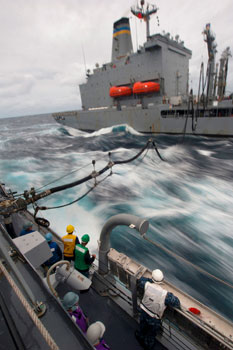The U.S. Navy has developed a breakthrough process to convert seawater into hydrocarbon fuel, a process that could lead to fueling stations at sea in decades to come.
Scientists at the Naval Research Laboratory (NRL) were looking for a way to reduce the U.S. fleet’s reliance on the 15 oilers operated by the Military Sealift Command that deliver 600 million gallons of fuel each year for aircraft-carrier jets as well as vessels. That means vessels must refuel at sea by running parallel with the tanker, regardless of the weather. During flight operations, carriers must take on jet fuel. The oilers are part of a fuel supply chain that may stretch thousands of miles.
If the Navy could develop a reliable, cost-effective way to make fuel from seawater, it could shorten the supply chain and reduce risks to vessels. Also, it would reduce the Navy’s reliance on fossil fuels.
Research chemist Heather Willauer was part of the NRL team that developed a workable method for recovering carbon dioxide and producing hydrogen from seawater. Then, using a catalytic conversion, the gas-to-liquids process converts carbon dioxide into fuel. The Navy focused on creating JP-5, the fuel used for Navy jets.
“Nobody had ever made fuel from seawater and demonstrated it before, and not only did we demonstrate it, we have a technology that will get hydrogen and CO2,” Willauer said.
The process should be able to adapt to produce liquid hydrocarbon.
“It’s a synthetic process, so theoretically you should be able to put in what you want and get out the type of fuel that you want; you could make designer fuels by changing the catalyst,” Willauer said. The process could also make liquefied natural gas or compressed natural gas, she noted.
One of the research goals for Willauer’s team was to develop the equipment in a small footprint that could be incorporated on a vessel.
“We’re trying to get our stuff into modular units so you could put them on a sea-based platform,” Willauer said. “That’s the vision, to get it out to sea somewhere, but you have to reduce its size and footprint.”
Commercialization will take further funding and a partnership with industry. Willauer said the NRL is consulting with Huntington Ingalls’ Newport News shipyard to put the technology in a ship design. Christie Miller, a spokeswoman for Huntington Ingalls, said the company can’t comment on the project.
“We have several milestones to overcome and demonstrate it, so then would the Navy pick it up or would a commercial entity further develop the technology? That’s where the question lies,” Willauer said.
One challenge is to make the process more efficient. Willauer said that it takes 23,000 gallons of seawater to make 1 gallon of fuel. The process requires large amounts of electricity.
“We’d like to continue our basic research and prove the concepts of the technology and get them over some of the major milestones in the research,” Willauer said. “But that will take funding and industry partners to do that.”

